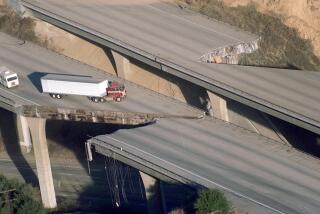Did you feel that? USGS releases new earthquake hazard map
The U.S. Geological Survey released new earthquake hazard maps for the nation on Thursday, expanding seismic risk areas along the East Coast and in California, among other areas.
The maps and supporting documentation are used by municipal planners, insurers and emergency response agencies and are intended to help limit damage and loss of life due to earthquakes.
“While all states have some potential for earthquakes, 42 of the 50 states have a reasonable chance of experiencing damaging ground shaking from an earthquake in 50 years -- the typical lifetime of a building,” the USGS said in a prepared statement.
As in past estimates, the threat of earthquakes is highest along the West Coast, the Intermountain West -- that region between the Rocky Mountains and the Cascade Range -- and several areas in the central and eastern United States.
The 16 states with the highest risk include Alaska, Arkansas, California, Hawaii, Idaho, Illinois, Kentucky, Missouri, Montana, Nevada, Oregon, South Carolina, Tennessee, Utah, Washington and Wyoming, according to the report.
The last map was released in 2008, and since then experts have expanded earthquake risk zones in several key areas.
Following the 5.8 magnitude earthquake that struck Virginia in 2011, experts have expanded risk areas in the eastern U.S. “It was among the largest earthquakes to occur along the East Coast in the last century, and helped determine that even larger events are possible,” the USGS said.
In California, the discovery of new faults raised hazard estimates for San Jose, Vallejo and San Diego. However, due to new understanding of earthquake fault processes, researchers downgraded threat estimates for Irvine, Santa Barbara and Oakland.
While researchers are studying the possible connection between industrial activities -- such as the dumping of wastewater in deep wells -- and a spike in earthquakes in states like Oklahoma, USGS officials said they were still trying to determine how to account for the threat of such events.
“Injection-induced earthquakes are challenging to incorporate into hazard models because they may not behave like natural earthquakes and their rates change based on man-made activities,” the USGS said.
Follow @montemorin for science news






